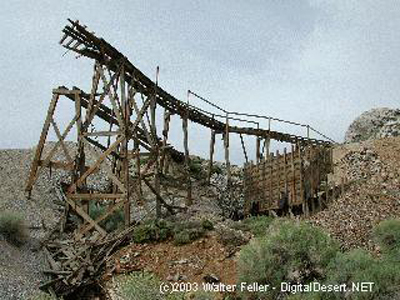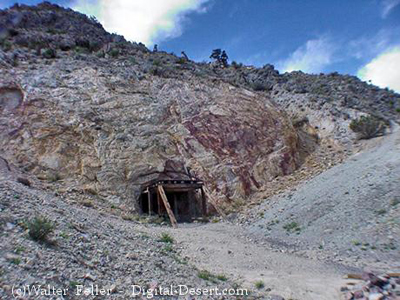Deserted and Hostile
As mining capital dried up in the mid-1860s, most of the mines within the California desert region were deserted. An outbreak of Indian hostilities at this time also contributed. One bright spot in the region during this time occurred in 1865 high in the Inyo Mountains with the discovery of the Cerro Gordo Mine. The first wagon of silver bullion from this mine arrived in Los Angeles in June 1868 for shipment to Selby Smelter in San Francisco (which had been erected in 1867). Regular shipments began arriving in Los Angeles in December 1868 and continued until the summer 1872. At that time the bullion was hauled over Tehachapi Pass to the Southern Pacific railhead near Visalia. However, this arrangement proved a disaster, and again in June 1873, Los Angeles became the recipient of Cerro Gordo’s output. The flow of silver-lead bullion continued through Los Angeles until April 1875 when the bullion route was again shifted over Tehachapi pass to the railhead of the Southern Pacific Railroad at Caliente, located at the base of the pass. In late July 1875 rails finally reached Mojave. The teams of bullion from Cerro Gordo soon were connected here. But by December 1876 the mine’s output had essentially come to an end.The discovery of Cerro Gordo in 1865 and the 1871 discovery of bonanza ore at the Comstock proved a stimulus through out the desert. As a result of the immense quantities of silver extracted from the Comstock between 1871 and 1878 several men became fabulously wealthy, and in general the investment climate greatly improved.
In the East Mojave the Ivanpah silver mines were actively mined beginning mid-1870 with ore shipped to the Selby smelter in San Francisco. A mill was erected at the New York Mine, located in the New York Mountains, in December 1873, though it ran only briefly. The McFarlane brothers later moved it to Ivanpah. By the mid-1870s two mills located near the town of Ivanpah were processing ore. About 10 miles south of Ivanpah, the Bullion and Cambria silver mines were productive in the early 1880s, and the Bonanza King Mine was found in the spring of 1880 when two prospectors from Ivanpah discovered silver ore in the Providence Mountains.
In Inyo County silver ore was discovered at Panamint in January 1873, at Darwin in October 1874, at Lookout in January 1875, and near Resting Springs in August 1875. Silver and gold were discovered in the hills above Oro Grande in the summer of 1879, and a substantial water-powered mill was erected along the Mojave River by April 1881. Silver was also discovered in 1879 at the Waterman Mine located just north of the Mojave River at what is now Barstow. A mill to work this ore was constructed in November 1881. At nearby Calico, silver ore was discovered in April 1881. Initially ore was hauled from the Silver King Mine at Calico to the Oro Grande mill. But within a couple of years there were a number of mills located in the vicinity of Calico.
Previous - Next

Cerro Gordo

Bonanza King